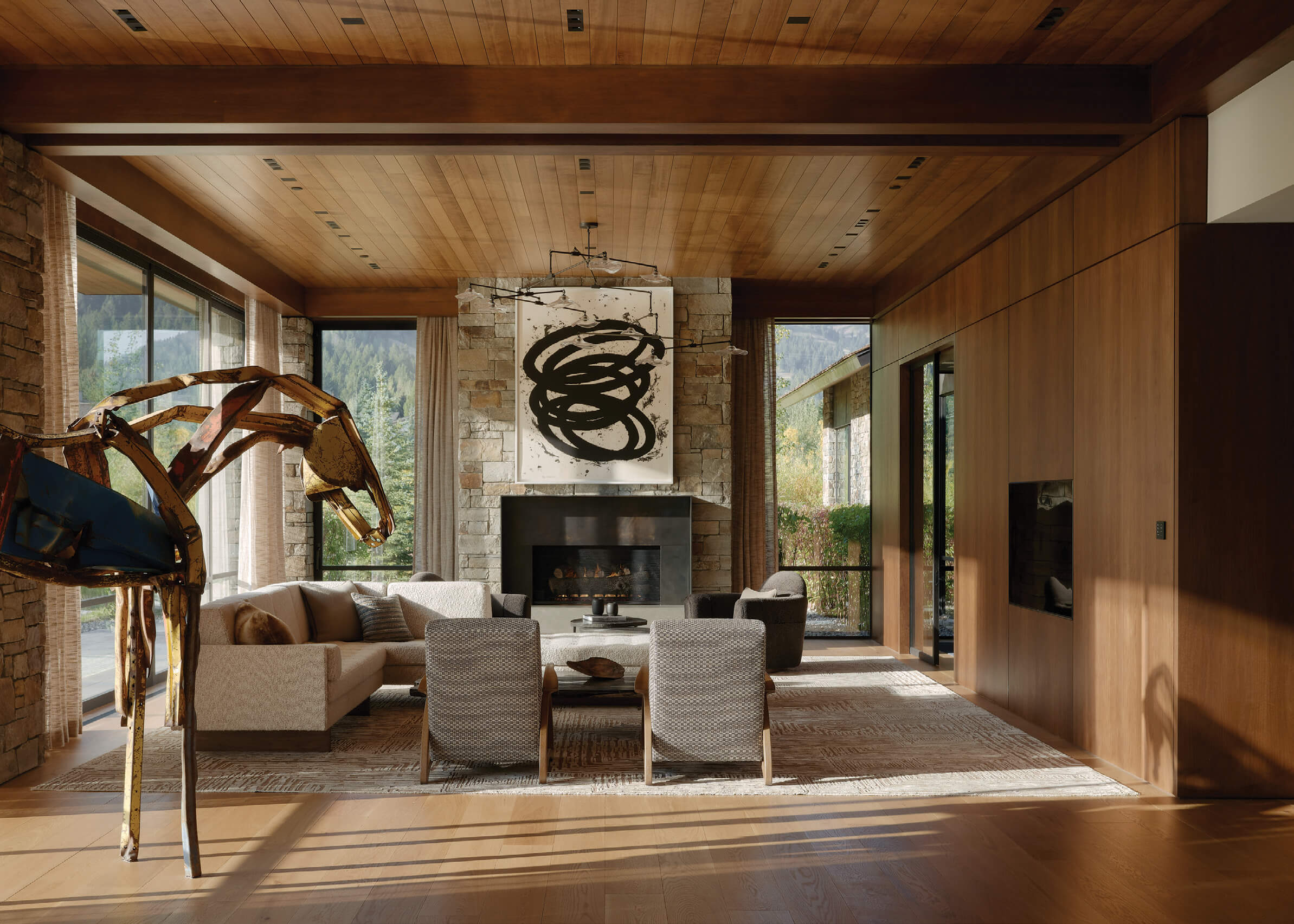
09 Aug Western Design: Art Forward
Jackson Hole, Wyoming, is a long way from Chicago, and different in just about every way. But when an Illinois-based family of four set foot in this Rocky Mountain town on previous visits, they always felt like they were home — so much so, that they decided to build one of their own.
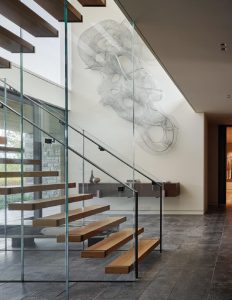
CLB Architects designed the contemporary glass-walled staircase to add an artistic touch and an airy, open feel. The wire wall sculpture is by Eric Gushee.
During previous visits to friends’ homes in the area, they’d admired the work of CLB Architects — a firm with offices in Jackson Hole and Bozeman, Montana — and when it came time to design their own house, that’s who they called on. “They wanted to engage an architect who could work within the traditional requirements of the development but create a more contemporary interior, all while keeping warmth and contextual materials of the West,” recalls Andy Ankeny, a principal architect with CLB.
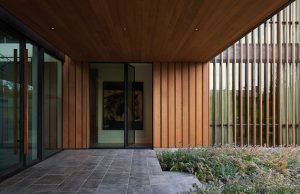
The architecture is warmed by wood-clad overhangs on the exterior.
On the approach, a two-story wing greets arrivals and speaks to the Teton Mountains, which tower behind it. The structure’s gabled forms rest on a stone plinth that lends a traditional touch, while the vertical gapped cedar paneling and fins over the windows lean toward a more contemporary style. Serving as privacy screens, the fins also unite the architecture on both floors and create a lantern effect at night.
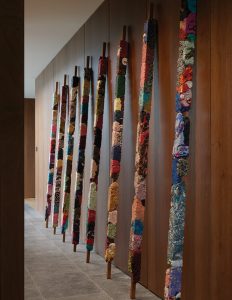
An array of contemporary totem poles by Manish Nai lead to the homeowners’ suite.
Strategically designed by Ankeny and CLB project manager Brent Sikora to maximize privacy and views, the house faces and opens up to a pond and the mountain backdrop to the west. Regional materials — western red cedar, quartzite stone veneer, limestone flooring, and patinated copper — help tie the architecture to place, while elements such as walnut, white Macauba stone slab, white oak flooring, and blackened stainless steel offer warmth, which is particularly important during the snow-heavy winter months.
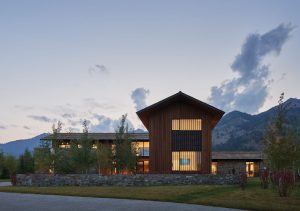
The home, built by OSM Construction, uses regional materials — including western red cedar, quartzite stone veneer, limestone, and patinated copper — to help tie the architecture to place.
A walkway punctures a stone wall and leads guests through lavender beds and an aspen grove before turning toward the front door. At this moment, the landscape architecture, by Jackson Hole-based Hershberger Design, complements the experience of the house and its art. A glass front door and entry, set within a copper-edged overhang, provides a direct view of the home’s keystone moment: a life-sized equine sculpture by Deborah Butterfield. Once inside, a foyer is defined by a sleek staircase suspended within walls of glass.
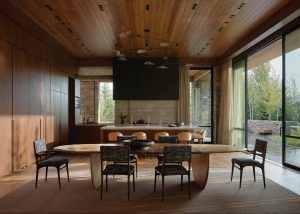
Lighting by John Pomp hangs over a Pebble Table from Hostler Burrows and Carlo de Carli dining chairs. The walnut-clad dining area and kitchen open to the landscape, which was planned and implemented by Hershberger Design with restraint, allowing the natural surroundings to take center stage.
“We’d wanted some indicators of contemporary glass architecture that presents itself only when you pass through the filter that is the front door, ” says Ankeny. “Then, when you come into this two-story volume of glass, the stairway is sculptural and light rather than heavy and solid. We spent a lot of time designing that; it’s our piece of art.”
In the gathering areas, floor-to-ceiling sliding doors lead to an outdoor living space that’s sheltered by a wood-lined overhang. Geothermal heating and cooling systems help limit the impact of the seven-bedroom home, which includes a den, office, gallery, guest rooms, a ski room, game room, and wine room. In addition, a bunkroom that’s trimmed in walnut and capable of comfortably accommodating 10 adults, features a small roof terrace and an outdoor living room.
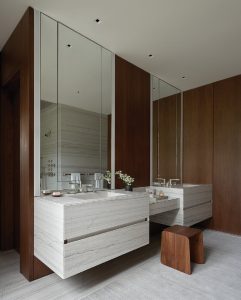
Minimalist bathrooms with floating vanities maintain a spa-like ambiance.
The builders — OSM Construction led by Mark Pollard and Kris Kasbaum — paid meticulous attention to detail that’s evident throughout, especially in the black steel window systems, custom hardware, and detailed architectural elements, such as the steel fireplace surround and kitchen hood, all of which add depth, weight, and longevity.
Throughout the property, inside and out, the family’s art collection is striking and of place, despite some Mid-century Modern pieces that were created far from the Northern Rockies, such as a Richard Serra painting in the great room and a Roy Lichtenstein piece over a credenza. While the artwork is contemporary, much of the subject matter speaks to the locale, including a painting of a cowgirl by Billy Schenck and an image by Bruce Cascia of the iconic Cowboy Bar sign in downtown Jackson. Pop art by Jon Langford adds a colorful playfulness and counters the gravity of other works, such as a monumental equine painting by Ken Peloke. Tried and true Western motifs — bison, aspen trees, cowboys, mountains, horses at pasture, tipis, Annie Oakley, and even a pistol pointing at the viewer — appear in unexpected areas.
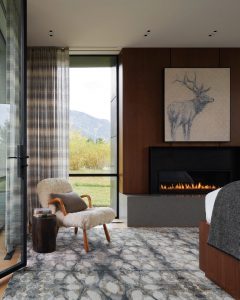
In the bedrooms, neutral-toned pattern sand textures keep the mood serene and the focus on nature, which was the primary goal of interior designer Shea Soucie of Soucie Horner Ltd. The elk painting above the fireplace is by Susan Hall.
Much of the art was collected prior to or during construction, and in some cases the house was designed around it. CLB created some 3-D renderings that display works in situ, and they collaborated with interior designer Shea Soucie, of the Chicago-based firm Soucie Horner Ltd., and art consultant and gallerist Thomas Masters.
Soucie, who had worked with the owners on several houses over the years, explains that the project’s success and seamless nature is due to the clients’ understanding of and appreciation for the process, and by always keeping the end result in mind. “There’s a whole lifestyle around collecting art,” Soucie explains. “It’s not just about an individual piece; it’s a collection for the house. We wanted the art pieces to be integrated. … We are always thinking to that end, but to have a client thinking this way is a different experience.”
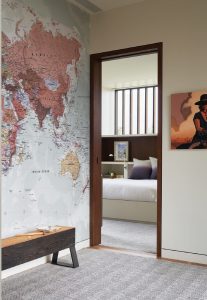
Art defines every space in the home. This room features a map-covered wall and a painting by Billy Schenck.
Between the bold art and the dramatic views, the interiors had to be subdued in tone yet still have a presence. Textural handwoven fabrics and rugs meld with both vintage and custom pieces. “I think when you’re designing a home that’s about setting and nature, you want the materials to be more subtle but still hold their own,” Soucie says. “We didn’t want them to blend, but we also didn’t want punches of color or whimsy. It was more about refinement and detail and respecting nature.”
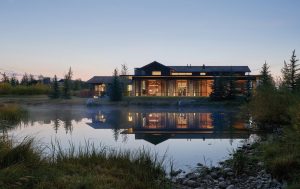
Since the home sits on the edge of nature, the architects at CLB avoided a monolithic presence by creating distinct masses for various living spaces.
A feeling of shelter was important too, Ankeny adds. “We wanted to make sure you could spend time admiring the art with some sense of enclosure, so you don’t feel exposed at night,” he explains. “All the spaces were scrutinized for scale and detail to make the house feel cozy and warm while still maximizing views to the mountains.”
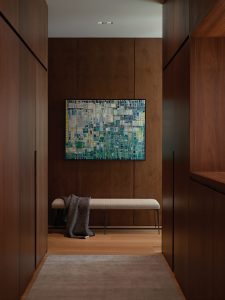
Two walnut-clad volumes lead the eyes down a hallway to a colorful abstract painting by Erin Kaya.
Chase Reynolds Ewald has been writing about Western design, food, art, travel, craftsmanship, and rustic style for more than 25 years. Bison: Portrait of an Icon, her 12th book and sixth collaboration with photographer Audrey Hall, was released in March 2021, and her book Modern Americana, with designer Max Humphrey, was released in April; chasereynoldsewald.com.




No Comments